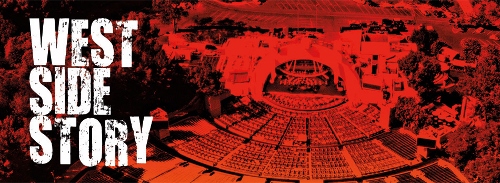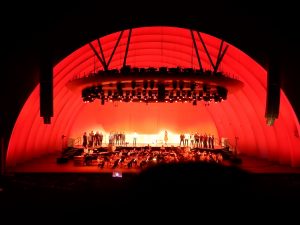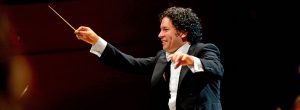HERE’S A PLACE FOR US
When I first heard West Side Story, it was the original Broadway cast recording on my parents’ mono Magnavox console. Without the Jerome Robbins’ direction and choreography, without the sets and costumes, and without the dialogue, I was transfixed over and over by the 1957 trailblazing musical, an updating of Romeo and Juliet. Even after seeing the movie version, I found myself returning to that album, one which remains transfixing to this day.
All of those styles in Leonard Bernstein’s rhythmic score’”classical, jazz, be-bop, blues, vaudeville. All of those themes in Arthur Laurents’ story’”belonging, true love, war, peer pressure. The dazzling street-wise sophistication of Stephen Sondheim’s lyrics. The grittiness and beauty of the seminal musical was captured so perfectly on vinyl that I only had to close my eyes to vividly see actors’ facial expressions and Jerome Robbins’ dances’”ballet, modern, cha-cha, and huapango, among others.
While the show, which transformed the Montagues and Capulets into 1950s’ streetgangs–the NYC hometurf Jets and the Puerto Rican Sharks–has never fallen off the radar; the last five years has seemingly exploded with productions both large-scale and intimate. I have seen four, but only a smaller version had the purity necessary to become an emotional ride. I think that while its themes remain virulently relevant, the show is a bit dated, and without a knockout cast and a full orchestra , even the most professional productions can lack something.
In 2013, conductor Michael Tilson Thomas received permission from Sondheim and the administrators of his co-authors’ estates to perform the score in concert form. This means no dialogue (unless it’s accompanied by music), no dance, no sets, and just representative costumes. The ensuing concert was recorded and the ambitious result–a two-CD set–was successful to a point; there were some engineering and casting issues.
Last night at the Hollywood Bowl, Gustavo Dudamel and the Los Angeles Philharmonic took their shot at the concert version, and gave us the royal treatment to one of the best scores in musical theater history, aided by the Los Angeles Master Chorale for the ensemble vocals. And even though it was only the music of West Side Story, the poignant and powerful evening–sans sets and dialogue–never sacrificed the emotional core. Surprisingly, the actors, whose lines had been chopped up (a few characters were deleted altogether) located the heart of this timeless tale. The program also took care of the issues I had with the SF Symphony CD. Rare is the occasion at the Bowl where you can hear a pin drop among 12,000 patrons.
It’s difficult for a philharmonic to capture both the driving jazz and silvery classical aspects of the orchestral pieces and dance interludes, but since Dudamel opted for a chamber-sized orchestra, he was able to nail the Latin-tinged “The Dance at the Gym”, the bebop/fugue of “Cool”, and the glassy, Copland-esque second act “Ballet Sequence.”
Although he sounded a bit like his streetwise newspaper striker Jack Kelly in Newsies, Broadway and TV heartthrob Jeremy Jordan blew me away with brand new choices for Tony–when he announced to Maria his real name “Anton” it was with a childlike embarrassment and manly defiance so authentic that audience members chuckled in sympathy. Solea Pfeiffer had an angelic soprano which occasionally wavered, but not jarringly so, and it was a perfect fit for the naive but soon-to-be wordly wise Maria. (You could hear emotion in their voices, but all eyes around me were glued to the giant screens–it was tough to look away from these magnetic performers.)
Karen Olivo reprised her Tony-winning turn as Anita, girlfriend of the Sharks’ leader Bernardo, and she was as vibrant, womanly, and sexy as always; and although the dances were cut, Olivo remained ever graceful even crossing the stage.
With his gravelly voice, Matthew James Thomas was better suited to play Jigger Crain in Carousel than Riff, and was a little guilty of that forced adolescent angst seen in so many productions, but he kept his “Cool.” The “Gee, Officer Krupke” number was comically performed by skilled actors who can sing, led by Drew Foster as Action, rather than by a facsimile of real juvenile delinquents, and the disarmingly theatricality of this 11 o’clock number truly worked (this song was choreographed by “Book Director” David Saint more than any other).
In a month where America has seen a record amount of bloodshed on its streets, the message of tolerance and forgiveness resounds in West Side Story, but this concert version made it more impactful than usual. When the thrilling mezzo-soprano Julia Bullock, even better than her turn on the SF Symphony CD, offered a classy, spiritual, pitch-perfect rendition of “Somewhere”, it was heartrendingly inspiring.
West Side Story
in concert at the Hollywood Bowl
Los Angeles Philharmonic
Gustavo Dudamel, conductor
played on July 14 & July 19 (review date), 2016
for future events, visit Hollywood Bowl




